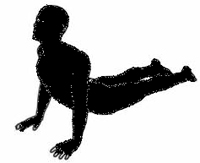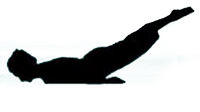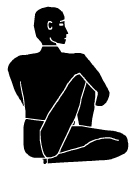Introduction

Constipation is a symptom, not a disease. Almost everyone experiences constipation at some point in their life, and a poor diet typically is the cause. Most constipation is temporary and not serious. Understanding its causes, prevention, and treatment will help most people find relief. Constipation is one of the most common gastrointestinal complaints in the United States. More than 4 million Americans have frequent constipation, accounting for 2.5 million physician visits a year. Those reporting constipation most often are women and adults ages 65 and older. Pregnant women may have constipation, and it is a common problem following childbirth or surgery. Regular exercise is often the best and easiest way to make sure your mind and body are revitalized. An active lifestyle ensures that your body gets the exercise it requires while improving appetite and digestion.
Yoga and Constipation
Constipation may probably be the main cause of most ailments common to humans. Yoga is the practice of different postures as a form of physical exercise and meditation. A number of positions in yoga may be beneficial in relieving bowel problems in people suffering with constipation. Abdominal lifts and knee-chest positions can increase intestinal motility and promote bowel regularity. Yoga can provide solution for each and every health problem.Practicing yoga regularly can ensure a healthy life. Yoga has proven very effective to treat the health disorder like constipation. As most of the yoga postures for constipation focus on the abdominal movement, it makes easier to pass the stools. Such asanas also help to improve the human digestive system and therefore cure constipation. These yoga postures will not only cure your constipation but also relive your from other disorders if combined with proper diet and adequate sleep. The ability of yoga to pump blood to various organs helps in the healthy functioning of organs and the organ systems of the body.
YOGA POSES FOR CONSTIPATION
Seated Forward Bend Pose
When you perform Seated Forward Bend, your abdominal organs are compressed and massaged. This stimulates your colon movement and thereby helps excretion system to function better. To perform this pose completely, while bending forward, do not forget to pull in your stomach to massage the abdominal organs.Marichi Pose
Marichi Pose (Marichi's pose) or Marichyasana is a twist sitting pose. The pose purifies the body by wringing toxins out of the internal organs. When you twist your torso, the intestine and colon inside the stomach are stimulated.Locust Pose
Yoga locust pose provides massages to the lower abdomen, enforcing the colon's movement which in turn easing the excretion system.Twists
These postures free energize and balance the body. Sitting twists are the most intensive, as they increase the range of motion of the spine. They promote flexibility in the spine, hips and upper back, thus relieving backaches, headaches, and stiffness in the neck and shoulders. This group of postures also tones and stimulates the abdominal organs, thus aiding digestion and relieving constipation. Ideally, twisting postures are done after a series of sitting poses or forward bends, which gives the hips and spine a proper warm-up. When done after backbends, they tend to relieve any lower back discomfort.Peacock Pose
This is a wonderful Asana for improving digestion. The whole abdominal organs are properly toned and stimulated well by the increase of intra-abdominal pressure. Sluggishness of liver or hepatic torpidity disappears. It tones the bowels and removes constipation (ordinary, chronic and habitual). It awakens Kundalini.Spinal Twist Pose
The whole abdominal organs are properly toned and stimulated well by the increase of intra-abdominal pressure. Sluggishness of liver or hepatic torpidity disappears. It tones the bowels and removes constipation (ordinary, chronic and habitual). It awakens Kundalini.The important physiological aspects of this posture (asana) are that it stimulates the pancreas, liver, spleen, kidneys, stomach and ascending and descending colons.YOGA ASANAS FOR CONSTIPATION
BHUJANGASANA

Steps
- Lie down on the floor, belly touching the floor, legs together, toes stretched backwards.
- Keep the palms near the chest and bend the head and the back upwards in a coverage position.
- Bending backwards is more important that lifting the body.
- Inhale and remain in this posture as long as you can hold the breath and then relax.
- Repeat this asana three to six times.
MAYURASANA

Steps
- Kneel on the ground. Sit on the toes. Raise the heels up. Join the two forearms together. Place the palms of the two hands on the ground. The two little fingers must be in close touch. They project towards the feet.
- Now bring down the abdomen slowly against the conjoined elbows. Support your body upon your elbows that are pressed now against the navel or umbilicus.
- Stretch your legs and raise the feet stiff and straight on a level with the head.
- When the Asana is in full manifestation the head, trunk, buttocks, thighs, legs and feet will be in one straight line and parallel to the ground. This posture is very beautiful to look at.
- Practise this Asana from 5 to 20 seconds.
- Retain the breath when you raise the body. When you finish the Asana, exhale slowly.
SARVANGASANA

Steps
- Lie straight, on your back on the floor. Palms should be on the floor close to the body and the heels and the toes should be together.
- Inhale and raise both the legs slowly up in a vertical position (at 90o). Raising of the legs should be synchronized with the breathing.
- Exhale and again raise the legs upward from the second position. Bring both palms underneath the hips and should be used to assist in raising the body upwards. The hands should always work as a support to the body weight.
- Try to raise the body as straight as possible.
- At the final stage of this asana you will be resting on your shoulders, chin touching the chest. In this position the legs should be stiff hard and together and the toes is pointing towards the ceiling. Do not shake. Be firm and keep breathing normally.
- Remain in this position for about 30 seconds on the first day.
- For returning to the first position, first fold the legs on the knees. Your heels should be now on the thighs and above the buttock. Then slowly let the body return to the floor while the palms are supporting the body weight.
- Now stretch out the legs forwards and relax. You have completed one round of the Sarvanga Asana.
SALABHASANA

Steps
- First rest in Makarasana. Then keep the hands below thighs and raise up both the legs together.
- The legs should be as straight as possible.
- Inhale and remain in this posture for a few seconds and then relax.
- Repeat this three to six times initially. After gaining sufficient experience you can remain in Shalabhasana for a longer duration, at a stretch.
- For easy practice start with each leg separately for six times. Then you can try raising both the legs.
ARDHA MATSYENDRASANA

Steps
- In this posture twist the waist laterally.
- Exhale and twist the waist in this posture.
- Inhale after you return to normal sitting position.
- Symmetry should always be maintained.
- If you twist your body six times to the left, you should also twist your body six times to the right.
HALASANA

Steps
- Lie on your back inhale to your fullest and lift your legs and trunk first to 30 degree, then 60 degree and finally 90 degree just as in sarvangasana, then take your legs back of your head making it 120 degree and beyond, this process should be done while exhalaling.
- Now rest the toes on the ground behind the head and breath normally, you can use hands on the back for support but ideally both in sarvangasana and halasana hands should be on flooe, palms touching the floor.
- When acquiring the posture of halasana the legs should be at 30 degree from the floor.
- Same process is done in reverse order while returning to normal position.
Diseases Related to Cancer |
||


